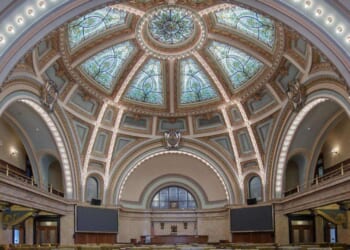A new plaque about the 17th century slave trader, Edward Colston, has sparked anger after failing to mention his philanthropic work.
The object was installed at the base of a plinth in Bristol, nearly five years after the statue which used to stand on top of it was torn down by protesters.
While the statue itself has since been rehoused in a museum, the plinth has remained empty and unchanged, until a new plaque was welded onto it on Wednesday evening.
But it has immediately sparked fresh debate, after it was found to have removed any mention of the merchants role as a ‘benefactor’ of the city of Bristol.
Instead, it emphasis his ‘prominent role in the enslavement of African people’, in a branded a ‘historical revision that is worthy of the Nazis’ by some critics.
The plaque is situated underneath a metal work sculpture that was part of the original monument, and which pays tribute to Colston as ‘one of the most virtuous and wise sons’ of Bristol.
Colston had made his fortune in the slave trade, before donating vast sums of money to charitable causes and endeavours in the city in his lifetime.
A statue in his honour had stood in a public square since 1895, before it was torn down by protesters and dumped in the harbour as part of a series of Black Lives Matter protests.

A new plaque was installed on the empty plinth of a 17th century slave trader, Edward Colston, failing to mention his philanthropic work
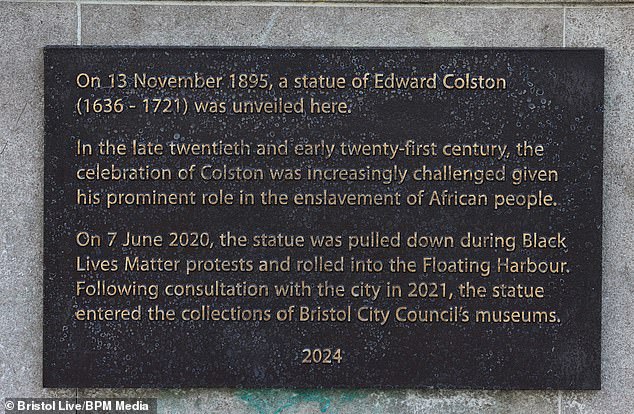
The plaque, installed on Wednesday evening emphasises Colston’s ‘prominent role in the enslavement of African people’
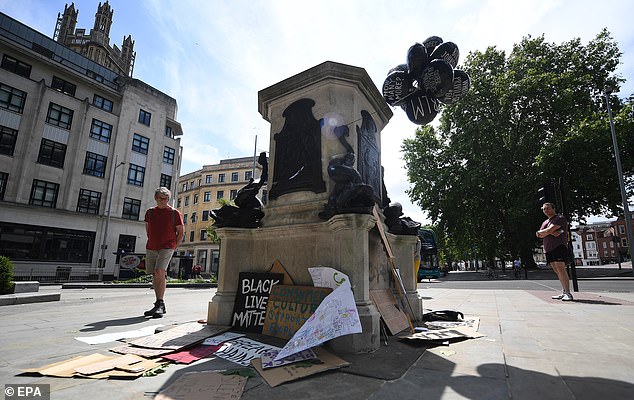
In June 2020, the statue was torn down by protesters and dumped in the harbour as part of a series of Black Lives Matter protests

After the statue was retrieved from the river, the city’s M Shed museum put it on display in order to ‘start a city-wide conversation about its future’
At the time, an estimated 10,000 protesters breached lockdown regulations and marched through Bristol following the unjust death of George Floyd, a black man in the US.
After the statue was retrieved from the river, the city’s M Shed museum put it on display in order to ‘start a city-wide conversation about its future’, next to some of the signs waved by protesters on the day the sculpture was pulled down.
It was then kept in storage while a city-wide survey was commissioned by the We Are Bristol History Commission.
The survey found that four-fifths of locals supported keeping it in a museum rather than putting it back on its plinth.
Following a Bristol City Council planning committee meeting in February 2024, councillors agreed to formally declare the statue a piece of museum property.
The council agreed that a new plaque would be placed on the plinth explaining Colston’s controversial history.
In November, Conservative city councillor Richard Eddy voted against the revision, calling it ‘utterly shameful’.
At the time, he said: ‘Deleting the reference to Edward Colston, one of Bristol’s greatest sons, being a benefactor is outrageous.

The council agreed that a new plaque would be placed on the plinth explaining Colston’s controversial history
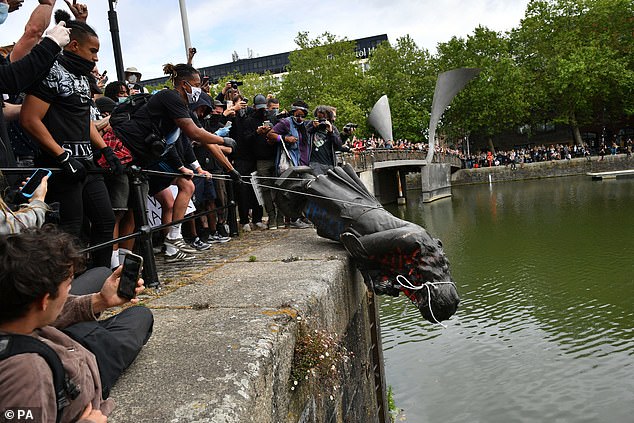
In 2020, an estimated 10,000 protesters breached lockdown regulations and marched through Bristol following the unjust death of George Floyd , a black man in the US
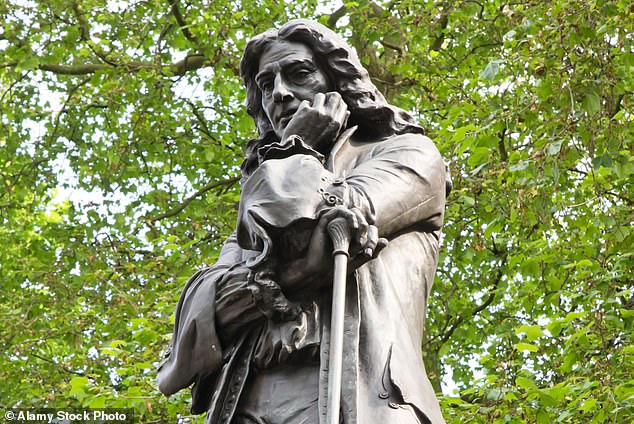
Colston’s bronze statue was created in 1895 by sculptor John Cassidy – it had been placed in the city centre with a plaque declaring him ‘one of the most virtuous and wise sons of (Bristol)’
‘An utterly historical revision that is worthy of the Nazis.’
The new plaque reads: ‘On 13 November, 1895, a statue of Edward Colston (1636-1721) was unveiled here.
‘In the late twentieth and early twenty-first century, the celebration of Colston was increasingly challenged given his prominent role in the enslavement of African people.
‘On 7 June 2020, the statue was pulled down during Black Lives Matter protests and rolled into the Floating Harbour.
‘Following consultation with the city in 2021, the statue entered the collections of Bristol City Council’s museums.’
The wording of the latest plaque was agreed after work by the Bristol Legacy Foundation, but councillors made changes and objected to it at several meetings in 2023 and 2024.
It has been placed below the original plaque, which described Colston as ‘one of the most virtuous and wise sons’ of the city.
The plaque is the fourth that has been created for the plinth – one was unofficially fitted in the 2010s as part of protests against the celebration of Colston, and another was created but never installed.
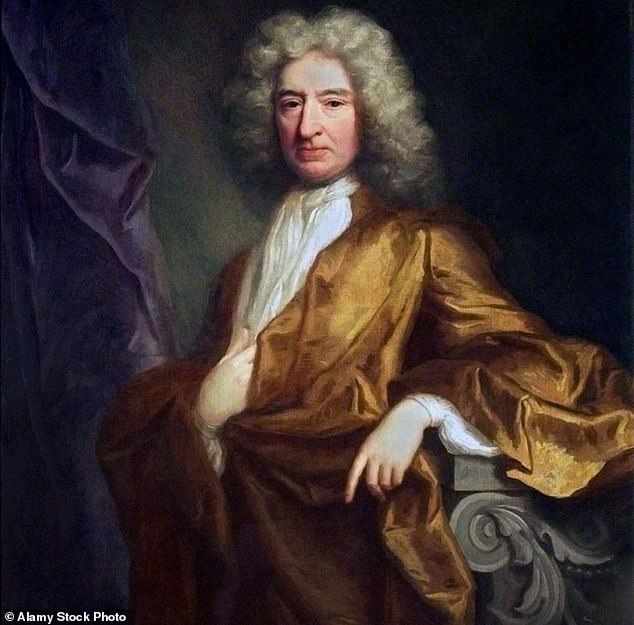
Colston used the wealth gained partially from his time with as a slave trader to fund hospitals, schools, workhouses and churches across England but particularly in Bristol
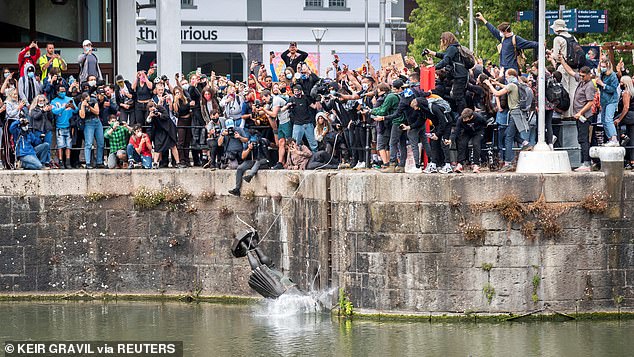
Last year, councillor Eddy described the people who pulled down the statue in 2020, known as the ‘Colston Four’ as a ‘mob of criminals and hooligans’ for ‘vandalising’ a listed monument
At a meeting last year, councillor Eddy described the people who pulled down the statue in 2020, known as the ‘Colston Four’ as a ‘mob of criminals and hooligans’ for ‘vandalising’ a listed monument.
The ‘Colston Four’, openly admitted their involvement in removing the statue, they argued their actions were justified because the statue was considered a hate crime to the people of Bristol.
After a police investigation, four people were charged with criminal damage.
Colston’s bronze statue was created in 1895 by sculptor John Cassidy.
It had been placed in the city centre with a plaque declaring him ‘one of the most virtuous and wise sons of (Bristol)’.
But his history as a one-time deputy governor of the Royal African Company, during which time it shipped tens of thousands of slaves from Africa to the Americas, has made him a locally divisive figure.
An estimated 84,000 slaves were transported during his time with the Company, and of those 19,000 may have died during the Atlantic crossing.
Colston used the wealth gained partially from his time with as a slave trader to fund hospitals, schools, workhouses and churches across England but particularly in Bristol, where he later served as an MP.




